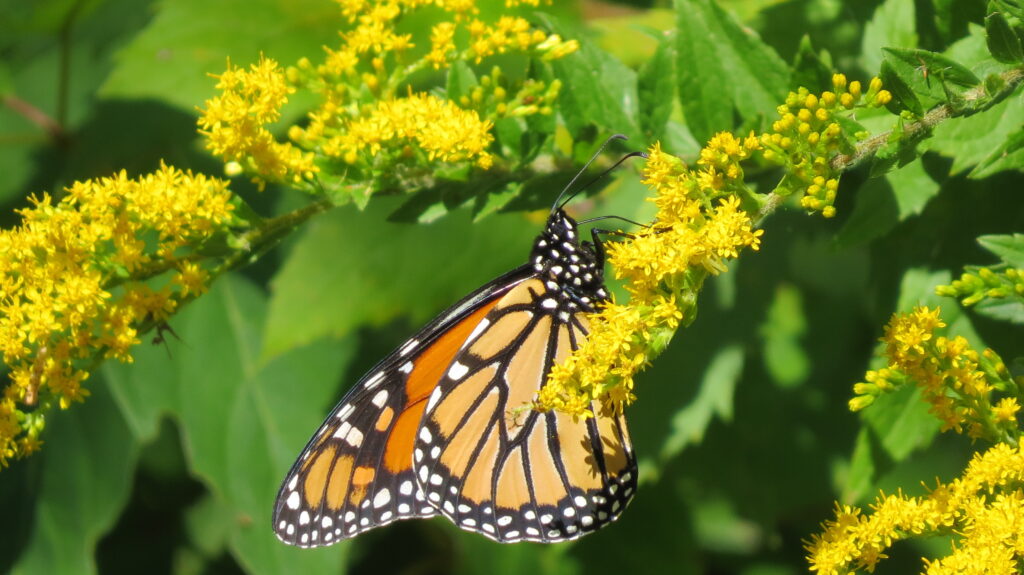by Mirka Zapletal
In late July the International Union for the Conservation of Nature (IUCN) gave migratory monarch butterflies (Danaus plexippus plexippus) an Endangered status on its Red List of Threatened Species after huge population losses in the last few decades. Mostly due to destruction of wintering habitat in Mexico & California and pesticide & herbicide use across North America, monarch populations in specific locations have dropped as much as 99.9 % since the 1980s. As communities plant more milkweed to help monarchs, there are questions about how closely local plant and insect communities are matched in timing throughout the year. Scientists are worried that earlier springs and warmer summers may be changing the timing of milkweed growth in ways that could spell trouble for the animals that depend on these plants.
The Newfound Lake Region Association is working with the Milkweed Adaptation Research and Education Network (MAREN) to track what is munching on milkweed, and when, to help researchers better understand what milkweeds and monarchs will be facing in the future. The yearly migration of monarch butterflies across North America is a wonder of nature now at risk due to habitat loss and climate change. NLRA’s work to preserve the natural resources of the watershed includes supporting native wildlife populations, such as monarchs, and managing Grey Rocks Conservation Area for wildlife as well as people. The pollinator areas at Grey Rocks provide dedicated space for native milkweeds to grow, creating a safe haven for monarch butterflies & caterpillars and giving us the chance to collect data for MAREN.
Join the “Munch Bunch”, NLRA’s citizen scientists tracking what is eating milkweed, and when.
On September 20 & 27 and October 4, 11, & 18 visit Grey Rocks Conservation Area between 2pm and 4pm to see what data collection will be like as part of the Munch Bunch, our crew of volunteer citizen scientists investigating monarchs and milkweed. NLRA education & outreach manager Mirka Zapletal will demonstrate how to collect data from common milkweed plants. Participants will become citizen scientists as they learn how to ID common insects found on milkweed, measure the plants, and estimate how much of a plant has been eaten.
The Milkweed Community
You might be familiar with the sight of milkweed plants growing along the roadside or watching milkweed seeds drift through the air in the fall when the pods dry out and split open, but have you taken a closer look to see what’s happening on those plants throughout the summer? We tend to think of milkweed plants as food for monarch butterflies, but they play important roles in the yearly cycles of many insects. If you look closely, you can find a variety of bees, bugs, beetles, and more – in fact, monarch butterflies are just the tip of the iceberg.
Check Out the Milkweed Munchers!
Even though milkweed sap is toxic to some animals, at Grey Rocks Conservation Area you can find:

Monarch caterpillars,

milkweed bugs,

and yellow aphids having a snack.

This ladybug is also looking for food, but not the plant kind – it preys on insects that eat the milkweed, like aphids.

And although it looks like these milkweed tussock caterpillars are really damaging the plants, they are the larvae of native moths and an important part of the local ecosystem.
Living in a Milkweed World
While you might be most familiar with common milkweed (Asclepias syriaca)- the kind you see growing wild along roads, at the edges of the sidewalk, and liberally spread through pastures- New Hampshire has at least 7 species of native milkweed, three of which you can find at Grey Rocks: common milkweed, swamp milkweed (Asclepias incarnata), and butterfly weed (Asclepias tuberosa). Each species has its own growth patterns- swamp milkweed blooms later than common milkweed- so together they provide a food source throughout the summer.

Swamp milkweed has pinkish flowers that are blooming in August…

…when butterfly weed already has long, pointed seed pods ripening.
The decline of monarch butterflies due to chemical use and habitat loss is a good example of how the different parts of an ecosystem are puzzle pieces that come together to build something greater than the sum of its parts- each puzzle piece is important and the system starts to fall apart when pieces are removed. Land development in the wintering range doesn’t just cause problems for monarchs in Mexico and California; likewise, herbicides that kill milkweed plants in the US and Canada have implications for monarchs in Mexico. A national program like MAREN can collect data across the entire range and, at the same time, bring together a larger community to work toward milkweed and monarch conservation. By contributing to MAREN’s work through citizen science at Grey Rocks and around the watershed, NLRA works to both join efforts by the larger community and protect the ecosystems outside our doors.
More Information

